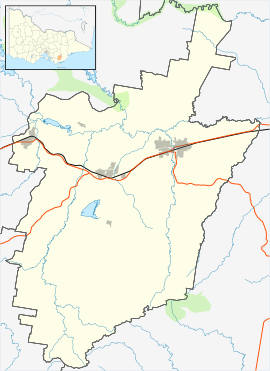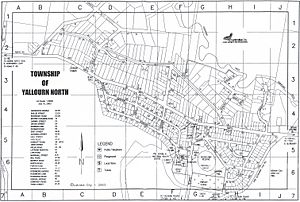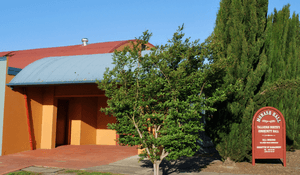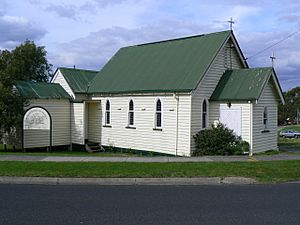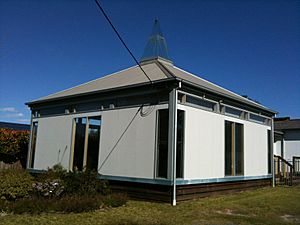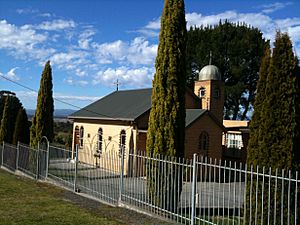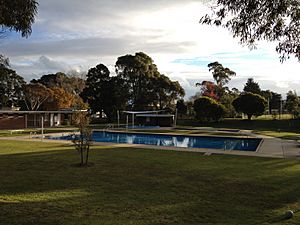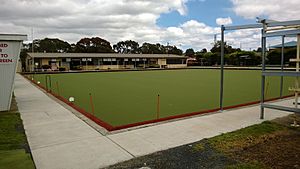Yallourn North facts for kids
Quick facts for kids Yallourn NorthVictoria |
|||||||||||||||
|---|---|---|---|---|---|---|---|---|---|---|---|---|---|---|---|
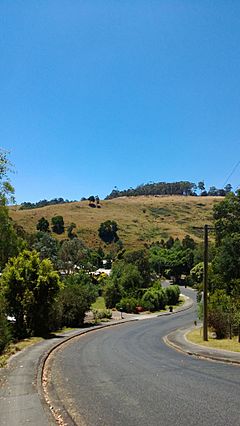
Homes on the undulating street of Marshall Street with a view of Harmony Hills in the background.
|
|||||||||||||||
| Population | 1,545 (2016 census) | ||||||||||||||
| Established | 1917 | ||||||||||||||
| Postcode(s) | 3825 | ||||||||||||||
| Elevation | 154 m (505 ft) | ||||||||||||||
| Location | |||||||||||||||
| LGA(s) |
|
||||||||||||||
| State electorate(s) | Morwell | ||||||||||||||
| Federal Division(s) |
|
||||||||||||||
| Website | Yallourn North | ||||||||||||||
|
|||||||||||||||
|
|||||||||||||||
Yallourn North is a town in the City of Latrobe, Victoria, Australia. It is about eight kilometres north-east of Moe. It is also 146 kilometres south-east of Melbourne. Before 1947, Yallourn North was known as "Brown Coal Mine". The Post Office opened in 1917 under that name.
This small town, located on a hilltop, has many churches. These include the only Serbian Orthodox Church and Mosque in the area. People in Yallourn North enjoy sports like Australian rules football, cricket, lawn bowls, netball, and angling. There is also a Social Golf Club and a pistol club. The town's Australian Rules football team, Yallourn-Yallourn North, plays in the North Gippsland Football League.
Contents
History of Yallourn North
How the Town Began
Yallourn North started because brown coal was found near Morwell in eastern Victoria. At first, private companies tried to mine the coal. But they were not successful. In 1917, the Victorian Mines Department took over the abandoned mine. This happened after coal miner strikes in New South Wales threatened Victoria's electricity supply.
Schools for Children
In 1917, a school was clearly needed for the children. A report suggested building a simple school. The school's address was "Great Morwell Coal Mine". A large tent, called a marquee, was used as the first school building. The school was given a temporary number, 3967, which it still uses today.
In December 1918, a storm tore the marquee. The school then moved to Bevis's Pioneer Boarding House. It stayed there until a new building could be built on the old site. As more people moved to the town, the school needed more space. The school building used today was built in the late 1960s.
Yallourn North During Wartime
During the Second World War, the area around the open cut mine was a "Prohibited Area" for aircraft. This meant planes could not fly there. In late 1941, anti-aircraft guns were set up to protect the mine. These were four Bofors guns. They helped protect the mine and the State Electricity Commission of Victoria (SECV) buildings.
Each group of four Bofors guns needed 90 people to operate them. However, neither the Australian Army nor the Volunteer Defence Corps could find enough operators. The guns were located roughly between Boundary Road and Anderson Avenue.
The Big Slip of 1950
Yallourn North changed a lot after 1950. On June 29, 1950, a huge amount of earth and brown coal slid into the old open cut mine. About 250,000 long tons of material slid 300 feet. Thirty people barely escaped being hurt.
After this "Big Slip," many shop owners moved their businesses. This is why shops in Yallourn North are not all in one central spot today. The eastern part of the town was also redesigned. New streets like Gooding Street, Low Road, and East Street were added.
Changes After Privatisation
In 1994, the Kennett Government sold the SECV to private companies. This had a big impact on Yallourn North's economy. Many people lost their jobs and moved away. About 4,500 jobs were lost in the wider Latrobe Valley by 1993.
However, in the last 20 years, the town has started to recover. The economy of Latrobe City is improving. New families are moving into Yallourn North, replacing those who left.
Monash Hall: A Community Hub
Monash Hall's Past
After the Big Slip in 1950, the town's shops temporarily moved into a camp recreation building. A Nissen hut was brought in pieces by trucks from an SECV work yard. It was set up in Reserve Street. Shops like Purvis's, Dobinsons Drapery, Meadows Bakery, and a hairdresser moved into the hut. They moved out when their new permanent locations were ready.
Ernie Pincini then turned the Nissen hut into a movie theater. It was supposed to open in November 1955. But due to a shortage of workers after the war, it didn't open until June 1961. Soon after, the first television signals reached the area. This led to the movie theater closing down.
After 1962, the hall reopened as a public space. It was also known as Yallourn North Hall. Today, it is called Monash Hall. In the 1990s, the hall got a small update and a fresh coat of paint. In 2008, the kitchen was improved even more.
Monash Hall Today
In October 2013, Monash Hall finished a big redevelopment worth $680,000. The regional growth fund helped pay for it. The local cricket club and junior football club decided to share facilities at the hall.
The renovations took eight months. They resulted in a new kitchen, new club rooms, and new toilets. There were also extra meeting rooms and wheelchair access. Mayor Sandy Cam officially opened it on October 15, 2013. Besides sports groups, other groups use the hall. These include Moartz, Line Dancers, and the Yallourn North Action Group. The Yallourn North Primary School also uses it. The hall has hosted ballet classes and even a primary school after a fire at the Hazelwood open cut mine.
Climate in Yallourn North
Yallourn North has an oceanic climate. This means it has warm summers and cool winters. The average highest temperature is 25.0°C in February. The lowest average high is 11.8°C in July. The average lowest temperature is 13.2°C in February. The lowest average low is 4.6°C in July.
Precipitation (rain, snow, etc.) is moderate, averaging 889.6 mm per year. However, rainfall happens often. It rains on about 175.5 days a year. This rain mostly comes from weather systems called troughs or cold fronts. These fronts are linked to winds from the Southern Ocean. The town is not very sunny. It has 182.8 cloudy days and only 47.0 clear days each year.
The hottest temperature ever recorded was 43.0°C on January 24, 1982. The coldest was -2.8°C on August 6, 1974. All climate information comes from Yallourn. This former company town is 9.8 km south of Yallourn North.
| Climate data for Yallourn SEC (38°11′S 146°20′E / 38.19°S 146.33°E) (154 m (505 ft) AMSL) (1949-1994) | |||||||||||||
|---|---|---|---|---|---|---|---|---|---|---|---|---|---|
| Month | Jan | Feb | Mar | Apr | May | Jun | Jul | Aug | Sep | Oct | Nov | Dec | Year |
| Record high °C (°F) | 43.0 (109.4) |
41.4 (106.5) |
38.2 (100.8) |
32.0 (89.6) |
25.6 (78.1) |
20.7 (69.3) |
21.8 (71.2) |
23.7 (74.7) |
29.5 (85.1) |
31.7 (89.1) |
35.6 (96.1) |
38.2 (100.8) |
43.0 (109.4) |
| Mean daily maximum °C (°F) | 24.7 (76.5) |
25.0 (77.0) |
22.5 (72.5) |
18.7 (65.7) |
14.9 (58.8) |
12.5 (54.5) |
11.8 (53.2) |
13.2 (55.8) |
15.1 (59.2) |
17.1 (62.8) |
19.9 (67.8) |
22.3 (72.1) |
18.1 (64.7) |
| Mean daily minimum °C (°F) | 12.7 (54.9) |
13.2 (55.8) |
12.1 (53.8) |
9.7 (49.5) |
7.4 (45.3) |
5.6 (42.1) |
4.6 (40.3) |
5.4 (41.7) |
6.6 (43.9) |
8.3 (46.9) |
9.8 (49.6) |
11.4 (52.5) |
8.9 (48.0) |
| Record low °C (°F) | 3.6 (38.5) |
4.2 (39.6) |
4.7 (40.5) |
1.7 (35.1) |
0.3 (32.5) |
−1.9 (28.6) |
−1.8 (28.8) |
−2.8 (27.0) |
−0.6 (30.9) |
0.4 (32.7) |
2.0 (35.6) |
4.8 (40.6) |
−2.8 (27.0) |
| Average precipitation mm (inches) | 51.0 (2.01) |
49.3 (1.94) |
60.0 (2.36) |
65.5 (2.58) |
87.6 (3.45) |
78.5 (3.09) |
83.1 (3.27) |
90.4 (3.56) |
88.9 (3.50) |
84.9 (3.34) |
81.3 (3.20) |
70.8 (2.79) |
889.6 (35.02) |
| Average precipitation days (≥ 0.2 mm) | 9.4 | 8.4 | 11.0 | 13.1 | 17.4 | 17.8 | 18.6 | 19.7 | 16.4 | 16.3 | 14.5 | 12.9 | 175.5 |
| Average afternoon relative humidity (%) | 48 | 49 | 54 | 59 | 68 | 72 | 70 | 65 | 62 | 60 | 56 | 53 | 60 |
| Average dew point °C (°F) | 10.8 (51.4) |
11.3 (52.3) |
10.8 (51.4) |
9.1 (48.4) |
7.9 (46.2) |
6.5 (43.7) |
5.4 (41.7) |
5.5 (41.9) |
6.3 (43.3) |
7.9 (46.2) |
9.1 (48.4) |
10.1 (50.2) |
8.4 (47.1) |
| Mean monthly sunshine hours | 260.4 | 223.2 | 198.4 | 165.0 | 127.1 | 96.0 | 117.8 | 145.7 | 170.5 | 198.4 | 210.0 | 235.6 | 2,148.1 |
| Percent possible sunshine | 58 | 58 | 52 | 50 | 41 | 34 | 39 | 44 | 46 | 49 | 49 | 51 | 48 |
| Source: Bureau of Meteorology (1949-1994) | |||||||||||||
Places of Worship
St. Brigid's Catholic Church
Building St. Brigid's Church began in 1933. The land was given by the SECV. It is on the corner of North Road and Reserve Street. Bishop Ryan officially opened and blessed it on March 1, 1936. The first mass was held that same day.
In 1950, Father Walsh helped make the church bigger. A T-shaped part was added to the back. The original building was lifted and moved to fit the new extension. Some church members collected money door-to-door to help pay for the work. In December 1979, the house next door became the official Presbytery (a home for the priest). It is now a private home again.
The Church of England
St. James's Church was built on "the hill" in Reserve Street. It was dedicated on November 17, 1927. The Church of England building from the small town of Morwell Bridge was moved to Brown Coal Mine. This happened because the Yallourn coal mine was getting bigger.
The building was meant to be used as a hall. But it was set on fire the night before it was moved. It needed a lot of repairs. It served the town for a while and was later removed completely. The first clergyman was Reverend Vizard. He was sent from Walhalla to the Brown Coal Mine in 1920.
The Methodist Church
Brown Coal Mine and Yallourn were first part of the Morwell church area. Reverend A.G.Day was the main minister. Before Yallourn was built, he held services at the school in Brown Coal Mine. In 1923, Reverend E.L.Vercoe was assigned to the area. He lived in the Eastern Camp. Services were held in camps, homes, and school buildings.
Reverend Vercoe bought a mess room in the 1920s. He had it set up at Brown Coal Mine. It was not far from the old Main Street. Volunteers changed the windows to make it look more like a church. A small room for the minister, called a vestry, was added. In 1938, the church was moved to Reserve Street by a team of bullocks. The main building was made longer. A bigger vestry and a new porch were added. A stained glass window was also put in. Later, a former washroom was added to the back of the church. It was fixed up to be a multi-purpose room. This room still serves the community today.
In 1977, the Methodist Church in Australia joined with the Presbyterian and Congregational Churches. They became the Uniting Church in Australia. On Boxing Day 1997, the church was badly damaged by fire. Only the community hall at the back was saved. The old church was taken down. A new, modern building was built on the same spot. A special service to open the new building was held on April 2, 2000.
Holy Trinity Serbian Orthodox Church
In 1950, many Orthodox Serbs moved to Yallourn. They soon wanted to build a Serbian Orthodox Church. On June 8, 1952, Serbs from Yallourn and nearby towns met. They decided to create a church and parish. The next year, Father Theodore Demjanjuk became the first priest. Services were first held in the Anglican church.
In 1957, land was given by the SECV to build the new church on North Road. The church hall was built and blessed in 1975 by Bishop Dimitrije. It has since been made wider to hold about 250 people. After Father Theodore, many priests served the parish. Currently, Father Milan Milutinovic holds monthly services. This is the only Serbian Orthodox church in the region.
Yallourn North Today
Yallourn North is still a small and quiet town. But it is always changing. In 2011, Yallourn North had 1,493 people. The town used to have more older residents. But many are moving to more suitable homes. This allows new families to move in. A few new houses have been built. There is also a new rural housing area outside the town to the east.
The town has a Foodworks supermarket. It meets many residents' needs. Larger supermarkets like Coles, Woolworths, and Aldi are in nearby towns. Other shops in Yallourn North include a fish and chip shop and a hairdressing salon. There is also a medical centre, a op-shop, and the Rossmore Hotel.
Yallourn North has two main sports areas. In town, there is the Yallourn North Hall and Reserve. This includes Monash Hall, the Junior Football Club, Cricket Club, and Tennis Courts. The other sports area is just west of town. It is called George Bates Reserve. This oval is home to the Senior Football club and Netball club. It also sometimes hosts cricket matches. The town also has a modern skate park and BMX track in the center. There is also a Fire Brigade training track.
The town has a lawn bowling club and a senior citizens club. There is also an angling club, a pistol club, and an outdoor swimming pool. You can also visit the Museum.
The town has a primary school with about 100 students. It takes part in the Stephanie Alexander Kitchen Gardens program. There is also a kindergarten and pre-school. Two electrical companies, Contracting Kings and Powersauce Electrical, are based in the town. They serve the wider Latrobe Valley area.
Community and Events
Yallourn North is becoming more focused on its community. After a decline following the SECV's privatisation, many recent events have helped improve community spirit. Two big examples are the Kelso Road Project and the Yallourn North Christmas Festival. There is also an annual Australia Day breakfast on January 26 at the Lion's park. A morning ANZAC Day Service is held on Reserve Street at the memorial on April 25.
The Kelso Road Project
The Yallourn North community came together after two members of the Sporton family passed away. To help the family, 140 volunteers renovated the Sporton family home. The original plan was to spend $30,000 on the renovation. But thanks to many donations from 208 community members and 70 local businesses, they raised $48,000. The final result was a completely updated home and garden. This was much more than the original plan for a new entrance and a "spruced up" kitchen, laundry, bathroom, and lounge room.
Yallourn North Christmas Festival
On December 5, 2014, Yallourn North held its first Christmas Festival. It started with a Twilight Market at Yallourn North Primary School. There were 70 stalls on the school grounds. After that, there were Christmas carols and a trivia quiz at Monash Hall. Other events included Barefoot Bowls at the bowling club, an outdoor cinema, and a pool party on the following days. About 1,000 shoppers visited the market. Another 1,000 people attended the other events.


